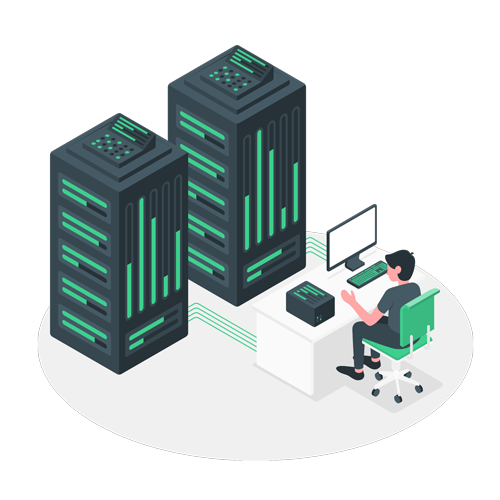ERP
Implementation of an ERP: 10 essential steps to achieve it
Table of contents
What is ERP implementation?
ERP (Enterprise Resource Planning) implementation refers to the process of implementing and deploying an ERP within an organization.
An ERP is software designed to manage and automate the business processes of a company by centralizing and harmonizing data in various areas such as human resources management, accounting, inventory management, supply chain management, and customer relationship management.
Software solutions like ERP offer numerous advantages, especially in terms of coordinating activities and optimizing overall performance.


What are the signs that a company needs to implement an ERP?
The implementation of an Open Source ERP in a company depends on various parameters, including the desire to expand services or a perceived need for change within the company.
10 steps to successful ERP implementation: our methodology
Implementing an ERP is a complex project that requires careful planning and close collaboration between the company and ERP software providers. Effective change management within the organization is also necessary to ensure project success.
To guarantee the success of your ERP implementation, here is a general methodology that can be followed:
1
Preparation
In this first step, it is necessary to form a dedicated project team with representatives from different departments of the company. Ensure you have project managers, key users, and technical experts to ensure effective collaboration throughout the process.
Identify the business processes that need to be addressed by the ERP and conduct a detailed analysis of functional and technical requirements to determine specific functionalities required.
ERP implementation requires adequate resources in terms of budget, personnel, and infrastructure. During this step, identify, allocate, and plan the necessary resources based on project needs.
Develop a detailed project plan by identifying tasks, timelines, and responsibilities for each team member to ensure a smooth and successful ERP implementation.

2
Needs analysis
During this phase, a thorough analysis of the company’s needs is necessary. This can be done through interviews with stakeholders and observation of daily activities.
The goal is to identify the key processes of the company that will be supported by the ERP. Determine the main activities that require automation to improve operational efficiency.
Once the key processes are identified, it is essential to conduct a gap analysis to determine the gaps between the features offered by the ERP and the specific requirements of the company. This analysis helps understand the customizations or additional configurations needed to fill these gaps.
This step also defines functional and technical requirements, which must be carefully documented in a specification document to ensure common understanding of needs and expectations among stakeholders.

3
Vendor identification and analysis
The identification and analysis of vendors aim to select the provider who will supply the ERP system that best suits the company’s needs.
Evaluate different ERP software available on the market based on your previously defined needs and goals. It is essential to analyze features, flexibility, scalability, the reputation of the provider, support, and associated costs.
This step allows you to select the ERP system that best fits your current and future requirements.

4
Design
Once you have selected the solution that best suits your needs, you can move on to the next step. In this phase, in collaboration with the provider, the design of the ERP software is developed based on identified needs. This includes configuring modules, defining workflows, customizing reports, and creating user interfaces.
This step configures the software based on the processes and business requirements of the company.

5
Development
Based on the requirements identified during the needs analysis, a project team works on the design of the ERP system. This involves defining the overall structure of the system, necessary modules and features, workflows, user interfaces, etc.
Once the design is established, the ERP system is configured according to the specific needs of the company. This includes parameterizing modules, integrating with other systems, customizing reports, etc.
A robust design, precise configuration, and rigorous validation are necessary to ensure that the system is ready to be used in production.

6
Data migration
Lors de cette phase, les données existantes de l’entreprise sont extraites des systèmes précédents, transformées et transférées dans le nouvel environnement ERP. Cela nécessite souvent des activités d’extraction, de nettoyage, de validation et de conversion des données pour s’assurer de leur intégrité et de leur conformité avec la structure du nouveau système mis en place.
If errors are identified during the verification of migrated data, cleaning and correction actions are taken to resolve issues. Once migrated data is cleaned and corrected, a final validation is performed to ensure that all necessary data is present in the new ERP environment and usable for daily operations.

7
Training
It is essential to train users of the integrated management software so that they can familiarize themselves with the new features. This involves creating training programs tailored to different roles and responsibilities of employees. This can include online training sessions or self-learning resources using reference documents and user manuals.
Once training is completed, it is essential to provide ongoing support to users to address their questions and resolve issues encountered during the use of the ERP system. This may include a dedicated support service, self-service resources, discussion forums, or additional training sessions if necessary.
The training step aims to ensure that users are comfortable and competent in using the system.

8
Testing and validation
Before full deployment, rigorous testing is implemented to ensure that the tool functions correctly. This step aims to ensure that configurations made in the ERP system correspond to the requirements and specifications defined during the project design phase.
Here are some commonly performed activities during this step:
- Review project definition documents: Review project documents such as the specification document or technical specifications to ensure that configurations made meet the project goals defined upfront.
- Perform validation tests: Validation tests are conducted to check whether configurations meet the company’s needs. These tests may include real usage scenarios, integration tests with other systems, etc. Test results are analyzed to detect possible non-conformities.
- Document gaps and necessary adjustments: Any identified gap between current configurations and project definitions must be documented. If adjustments are needed, they must be recorded and processed as part of the change management process.
This step is essential to ensure that the ERP is correctly configured before moving to the deployment phase.

9
Deployment
Once tests are conducted and validations completed, the ERP system is deployed throughout the organization. Depending on the size of the company and the complexity of the implementation, ERP system deployment can be done progressively or all at once. In a progressive deployment, the system is put into production in stages, starting with specific departments or sites and gradually extending to the entire organization
In a full deployment, the system is put into production simultaneously in all departments and sites.
The deployment step marks the transition from development to the actual use of the ERP system.

10
Monitoring and Maintenance
The final step is to continue monitoring, maintaining, and regularly updating the ERP system to ensure its proper functioning and to meet the evolving needs of the company.
Preventive maintenance actions are taken to prevent potential problems and maintain tool performance. This may include regularly scheduling backups and restores, managing software updates, managing system performance, etc.
It is important to note that each company and ERP implementation project is unique. To ensure project success, it may be necessary to adapt this methodology based on the specific needs of your organization.


Is ERP implementation reserved only for large companies?
ERP implementations are not reserved solely for large companies. Companies, whether medium or large, can implement an ERP based on their specific needs. The benefits of an ERP, such as process integration, effective data management, and increased visibility, are beneficial for all businesses, regardless of their size. ERP providers often offer different solutions tailored to the needs and budgets of different companies, allowing for scalable and customized implementation based on the size and goals of each business.
The success of an ERP implementation project serves as a development lever for all companies.
How to prevent delays during ERP implementation?
Preventing delays during ERP implementation can be achieved by taking several preventive measures. Here are some tips to help you avoid delays:
Project planning and management
Thorough planning is essential to define deadlines and resources needed for the project's smooth progress. Develop a detailed plan by identifying key steps, milestones, and responsibilities of each team member. Effective project management throughout its lifecycle contributes to preventing delays.
Clear definition of requirements
In-depth analysis of business needs and precise definition of requirements are essential to avoid late changes and adjustments in the implementation process. It is important to understand the company's needs and document them clearly and in detail from the outset.
Change tracking and management
Establish a regular tracking process to assess project progress, identify deviations from the plan, and take corrective measures if necessary.
User training and preparation
Ensure sufficient time is allocated for user training on the software. Proper training will help employees understand new features and processes, reducing delays related to adoption and use of the system.
Supplier engagement
Collaborate closely with the ERP provider to ensure they adhere to agreed-upon deadlines and provide necessary support throughout the implementation process. Establish regular checkpoints with the provider to assess progress and address any potential issues.
By following these recommendations and maintaining a proactive approach throughout the ERP implementation, you can prevent delays and keep the project on track.
What changes will ERP undergo once implemented in the company?
The typical lifespan of an ERP is generally estimated to be between 7 and 10 years. During this period, it will undergo various types of modifications:
From the software publisher's perspective:
- Updates and improvements: ERP providers regularly release updates to enhance existing features, fix bugs, and meet new regulatory requirements.
- Integrations with new technologies: The rapid evolution of technology provides opportunities for integration with innovative tools. Integration possibilities include the Internet of Things (IoT), artificial intelligence (AI), machine learning, and blockchain.
From your initiative:
- Addition of features and/or modules: You can customize the ERP to your specific needs by making additional customizations and configurations. This may include adding custom fields or creating tailor-made reports.
- Addition of users: As the company expands, there is often a need to add new users to the ERP.
Why choose the Axelor solution?
Axelor ERP is a Full web solution available in Cloud or On-premise mode. It is the only ERP that integrates Low Code/No Code BPM natively. This allows you to model any business process, even the most complex ones, and deploy the process in one of the business applications without code!
The Axelor solution is Open Source and stands out by being customizable and adjustable according to the needs of the using company. It is a fully personalized software that can evolve according to specific needs and expectations.
Axelor has a wide network of partners around the world who can leverage their expertise for your project. Whether in production, distribution, finance, or other sectors, our partners cover a broad range of industries.
A specialized integrator in your sector will guide you effectively, considering the specificities of your profession and its requirements.
Find out how our ERP can help you improve your business performance
An expert will contact you shortly to discuss your project.